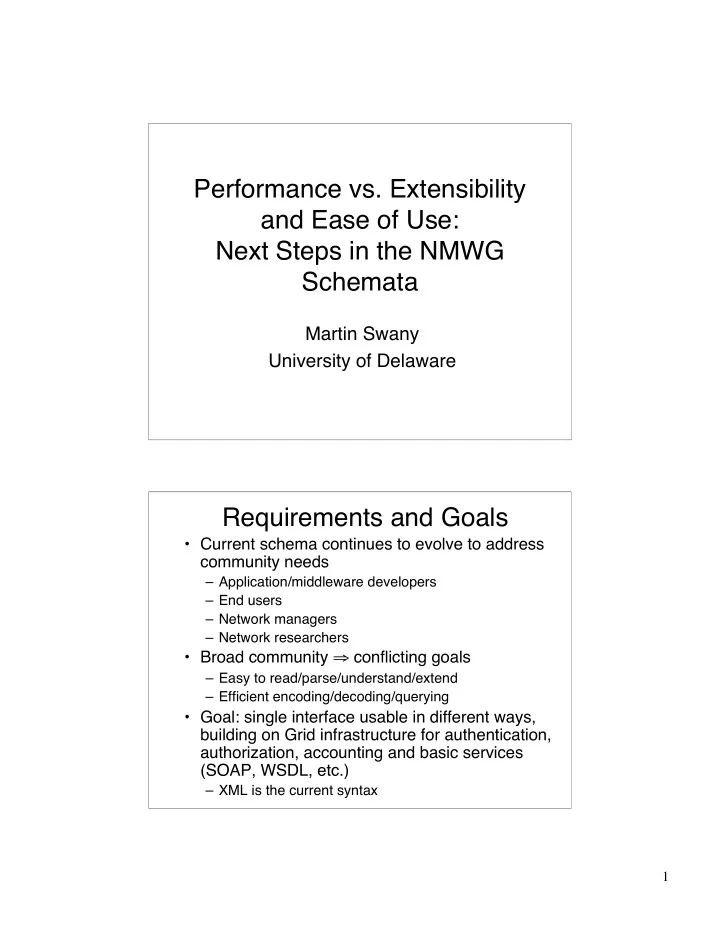

Performance vs. Extensibility and Ease of Use: Next Steps in the NMWG Schemata Martin Swany University of Delaware Requirements and Goals • Current schema continues to evolve to address community needs – Application/middleware developers – End users – Network managers – Network researchers • Broad community ⇒ conflicting goals – Easy to read/parse/understand/extend – Efficient encoding/decoding/querying • Goal: single interface usable in different ways, building on Grid infrastructure for authentication, authorization, accounting and basic services (SOAP, WSDL, etc.) – XML is the current syntax 1
Data/Metadata Separation • For a series of data, much of the metadata is consistent • Therefore we separate the consistent parts of the metadata by reference – Reference is to an XML object, which may or may not be included in the same SOAP message • Simply need to refer to an ID that is unique within some scope – Single document, single connection, single session, global (with URI, Grid Svc Handle,…) Data Normalization • All data can be identified by 3 broad classes of metadata and a timestamp – Characteristic • What was being measured, the type of event – Entity/Subject/Target • What entity was measured, generated the event – Parameters/Methodology • What parameters were fed to the measurement tool, what were the conditions under which the event was generated, by whom, what system, etc. • Self-contained instances of data can be formed by performing logical joins on these basic components 2
Normalization Example • Consider a set of available bandwidth measurements made periodically • Long-running middleware can initially determine the characteristic and its parameters • Subsequent queries can request values in a certain timestamp range to learn recent values and variance – Potentially significant reduction in overhead • Even historic packet/application traces Example 2 - Traceroute • We can normalize a single execution of traceroute into a series of packets sent from src to dst with various TTLs • As opposed to encoding the output as a string or a list of numeric quantities. • The individual elements have a common ID • This makes forward and reverse path trees (or path fan-in and fan-out) expressible as a simple set of queries • Some versions of traceroute allow specification of the initial TTL – Perhaps after the first “few” traceroutes return consistent hops 1-3, subsequent queries can begin at the diverging hop 3
Functions on the data • Clearly, some statistical analysis of data can be useful • Often more efficient to get summary data • Some folks want to do it themselves • So, you can get the raw data or have a specific function performed on the data • Use WSDL to describe functions’ input, output even if those functions are invoked in series on the server side Derived data streams • Timeseries transformations based previously mentioned functions • The subject becomes a view – a subject, characteristic, parameters, timestamp query • The characteristic and parameters encode the transformation on the original data • OWAMP only makes averages available – Our approach can describe the transformed data stream 4
Other potential benefits • Result verification against private data – Create service instance to perform remote analysis • In general, I might have some data that I can allow you to run certain queries against, but not download completely Summary • We must allow for various levels of use via the same mechanisms – Inline metadata is a logical join of data and metadata • Function chaining with WSDL signatures allows for management of remote processing – Derived data streams – Description of processing steps for available data 5
Recommend
More recommend